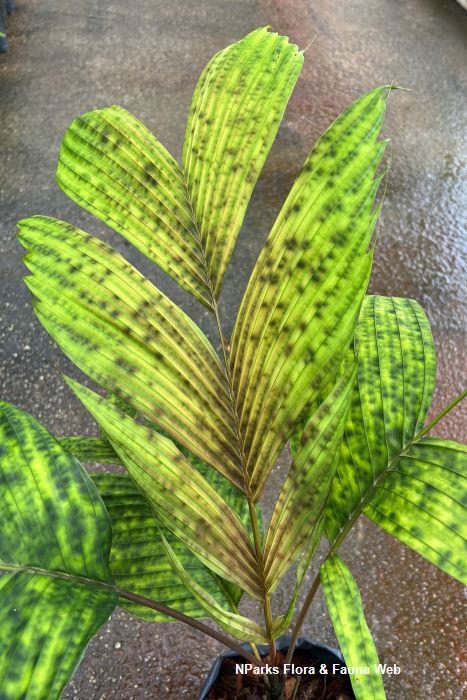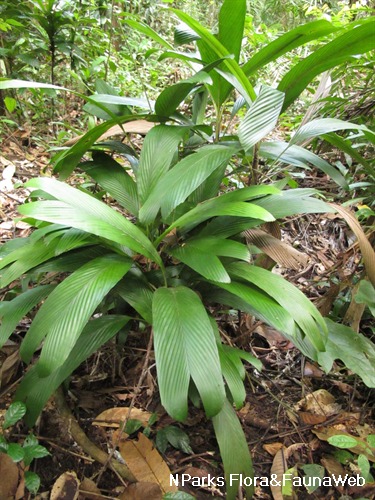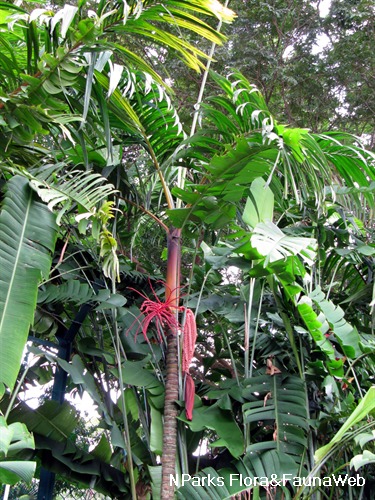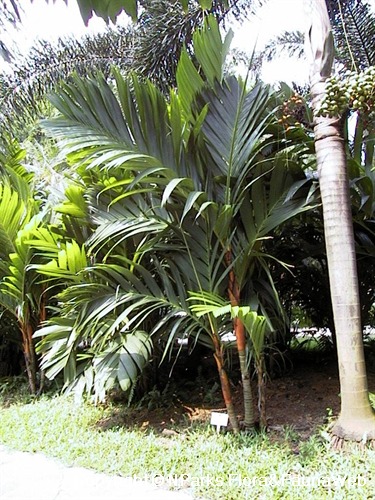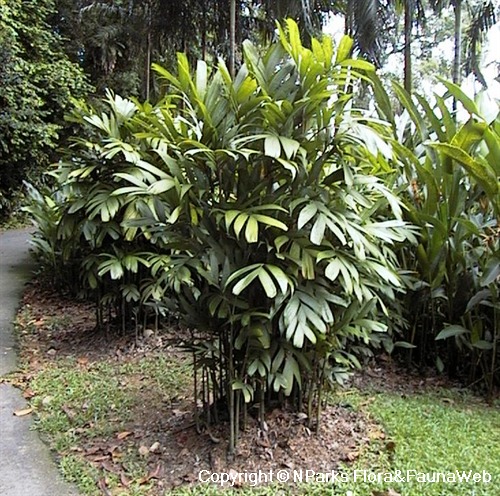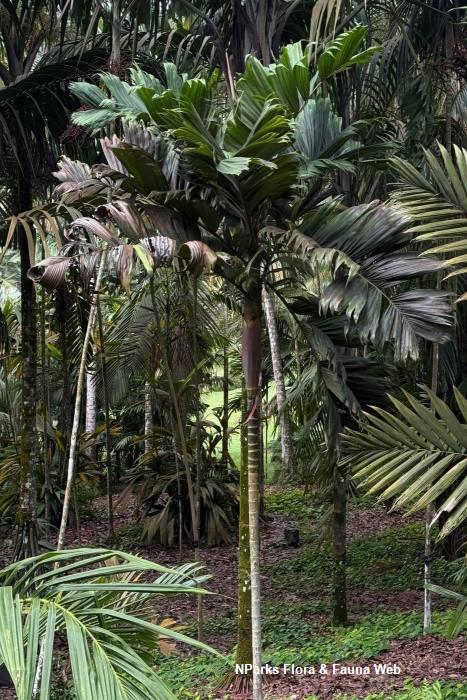
Back
Pinanga bicolana Fernando
| Family Name: | Arecaceae (Palmae) |
Pinanga bicolana is a thin, solitary palm endemic to Luzon, Philippines. Growing up 3 m tall, the palm produces mottled, even-pinnately compound fronds with irregular groups of leaflets. The mottling is more prominent in juvenile individuals.
Name
Classifications and Characteristics
| Plant Division | Angiosperms (Flowering Seed Plants) (Monocotyledon) |
|---|---|
| Plant Growth Form | Palm (Solitary Habit) |
| Lifespan (in Singapore) | Perennial |
| Mode of Nutrition | Autotrophic |
| Plant Shape | Fountain (Palm-like) |
| Maximum Height | 3 m |
Biogeography
| Native Distribution | Philippines (Luzon) |
|---|---|
| Native Habitat | Terrestrial (Primary Rainforest) |
| Preferred Climate Zone | Tropical |
| Local Conservation Status | Non-native (Horticultural / Cultivated Only) |
Description and Ethnobotany
| Growth Form | It is a solitary palm, up to 3 m tall. |
|---|---|
| Trunk | The trunk can reach 4 cm in diameter, and is visibly ringed with green or reddish-brown internodes up to 6 cm long. |
| Foliage | The fronds are medium-sized (about 0.75 - 1 m long), semi-erect, and even-pinnately compound with 10 jagged-edged leaflets on either side of the rachis. The leaflets are irregularly fused in clusters, with each made up of 1 - 6 leaflets. The terminal leaflets are united into a pair, about 18.5 cm long and 12.5 cm wide, and made up of 14 pairs of leaflets. The rachis is angular and rounded below, up to 0.6 - 1.5 m long. The petiole is 25 cm long and 1.3 cm wide, channelled above and convex below. Both rachis and petiole are covered in dense, brown, scaly coating. The fronds are dark green on the top and slightly mottled with blotches of light shade on the underside. New fronds are bronzey-red, still mottled. The mottling is more visible on young plants. Seedlings have undivided and bifid fronds. |
| Crown Shaft | The crown shaft is elongated, cylindrical and slightly swollen. It is dull light green and covered with the same coating as the rachis and petiole. |
| Flowers | The inflorescence is pendulous and infrafoliar, emerging below the fronds and crown shaft, and subtended by a spathe or peduncular bract. It is orange when fresh and branches up to 1 order with 5 - 8 deflexed, distichous (in two opposite rows) rachillae (minor, secondary axes on inflorescences), each about 9 - 14 cm long. Triads of male and female flowers are arranged distichously throughout each rachillae. The sepals and petals are smooth; the sepals are fused at the base while the petals are free. |
| Fruit | The fruits are smooth, oblong to ellipsoidal drupes, up to 2.2 cm long x 1.4 cm wide. They ripen to red, then purplish-black. The single seed is broadly ovoid, 9.5 mm long x 9 mm wide. |
| Habitat | It can be found in dipterocarp forests, 100 - 200 m above sea level. |
| Similar | This species is similar to Pinanga copelandii with both bearing distichously arranged fruits along the rachilla. They can be distinguished by P. bicolana having prominently beaked, oblong-ellipsoidal fruits with the skin drying smooth and rarely more than 8 rachillae while P. copelandii has shortly beaked, ovoid fruits with the skin turning finely striate when dry and often more than 8 rachillae. |
| Cultivation | It grows best in well-drained, loamy soil and full sun or partial shade conditions. It can be propagated by seeds. |
| Etymology | The genus Pinanga is derived from the Malay vernacular name, Pinang, for the Betel Nut Palm (Areca catechu). The specific epithet bicolana is likely named after the Bicol National Park in Luzon, Philippines, where the examined specimens were from. |
Landscaping Features
| Desirable Plant Features | Ornamental Form, Ornamental Foliage |
|---|---|
| Landscape Uses | Parks & Gardens |
Plant Care and Propagation
| Light Preference | Full Sun, Semi-Shade |
|---|---|
| Water Preference | Moderate Water |
| Plant Growth Rate | Moderate |
| Rootzone Tolerance | Fertile Loamy Soils, Well-Drained Soils |
| Propagation Method | Seed |
Foliar
| Foliage Retention | Evergreen |
|---|---|
| Mature Foliage Colour(s) | Green, Green - Light Green, Patterned, Purple |
| Mature Foliage Texture(s) | Powdery / Waxy Bloom |
| Prominent Young Flush Colour(s) | Red, Brown |
| Foliar Type | Compound (Even-Pinnate) |
| Foliar Attachment to Stem | Petiolate |
| Foliar Shape(s) | Palm Fronds (Pinnate / Feather) |
| Foliar Margin | Entire |
| Leaf Area Index (LAI) for Green Plot Ratio | 4.0 (Palm - Cluster) |
Non - Foliar and Storage
| Trunk Type (Palm) | Aboveground, Solitary Habit |
|---|---|
| Root Type | Underground (Fibrous Root) |
Floral (Angiosperm)
| Flower & Plant Sexuality | Unisexual Flowers , Monoecious |
| Flower Texture(s) | Smooth |
|---|
| Flower Grouping | Cluster / Inflorescence |
| Flower Location | Axillary |
| Inflorescence Type | Panicle |
| Ovary Position | Superior / Hypogynous |
| Flowering Habit | Polycarpic |
Fruit, Seed and Spore
| Mature Fruit Colour(s) | Red, Purple |
|---|---|
| Mature Fruit Texture(s) | Smooth |
| Fruit Classification | Simple Fruit |
| Fruit Type | |
| Mature Seed Texture(s) | Fibrous |
| Seed Quantity Per Fruit | Few (1-5) |
References
| References | Fernando, E.S. (1988). The Mottled-leaves Species of Pinanga in the Philippines. Principes, 32(4), 1988; 165-174. |
|---|
Image Repository
Others
| Master ID | 30936 |
|---|---|
| Species ID | 5320 |
| Flora Disclaimer | The information in this website has been compiled from reliable sources, such as reference works on medicinal plants. It is not a substitute for medical advice or treatment and NParks does not purport to provide any medical advice. Readers should always consult his/her physician before using or consuming a plant for medicinal purposes. |



